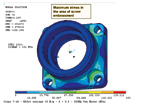
The telecommunications market is dynamic, constantly evolving and requiring significant product innovation in order to meet the demands of the 21st century. To do so manufacturers must react to market needs and possess the expertise to instigate innovative processes, while also maintaining competitiveness. This is the approach taken by Radiall, which has aligned its strategy around these key issues and given priority to innovation in the development of its new 7-16 composite flange receptacle.
Intermodulation
The starting point for development was the fact that in modern mobile telecommunications systems it has become a basic requirement to use passive components that do not generate third-order passive intermodulation products for all pieces of equipment from the antenna to the duplexer. Many studies have been completed by research labs and connector manufacturers to identify and quantify the various sources of nonlinearity, which can be generated by a passive component.
Their findings show that the materials, plating, contact pressure at the piece-part junctions, current line deviations, contact cleanliness and contact types all have a very strong impact on the generation of passive intermodulation products.
Single-piece Design
The resulting design modifications from these studies have been implemented, year after year, on the 7-16 connector series, which has become the connector that is most frequently used when a stringent intermodulation requirement is imposed. It is a low IM 7-16 flange receptacle design in a single-piece body that utilizes silver-plating for all metal parts and features strong attachment of the insulator and center contact into the body that effectively prevents any movement. It was also seen as important to address the weak point of conventional connectors, namely the connector attachment to the equipment panel.
Basically, the use of four screws to attach the flange to the equipment creates pressure distribution on the electrical contact joint that is directly dependent on the distance between the contact and the screws. In short, contact junction pressure is uneven and this irregular contact pressure is significantly amplified when screw torques are unequal. Figure 1 shows a stress calculation, illustrating the effect of tightening the flange screws. In order to minimize this problem, connector manufacturers have increased the pressure by reducing the contact surface by confining it to around the coaxial line. This approach makes the problem less acute, but does not eliminate it.

New Design
In order to fully eradicate this problem, Radiall has introduced a new receptacle concept whereby the contact pressure on the equipment side is generated by pressure applied by the 7-16 plug. Consequently, when a plug is mated to the receptacle, the tightening torque is diverted by the thread system into an axial force that is applied to the reference plane with the result being that the pressure on both contact junctions is equally distributed.
Effectively, the entire force generated by the tightening torque is efficiently transformed and used as an axial force on the contact junctions at the reference plane and panel junction. This improves the intermodulation level and its stability.
Through this concept, the receptacle body is only used as a mechanical support, which guides the reduced mass contact and no longer has an electrical function. This new degree of freedom has the added advantage of enabling the use of different materials that can be selected to offer certain features and meet specific practical needs.
Material Selection
In deciding on the material for the 7-16 composite flange receptacle, the main considerations were it had to be very lightweight, have high corrosion resistance and be colorable to enable color coding. Material selection was also based on:
• Material stiffness—Young’s modulus
• Yield limit
• Ultimate strength
• Temperature range
• Creeping speed and stress relaxation
• Thermal dilatation coefficient
• Sensitivity to harsh outdoor environments—corrosion, UV ageing, humidity, etc.
• Flammability rating
• Density
• Price

As an example, Figure 2 gives a comparison of the creeping behavior of different materials.
Taking all of these factors into consideration, an in-depth analysis revealed that the use of a composite material would meet these requirements and offer considerable advantages, including a weight reduction of more than 50 percent. Not only does the weight reduction of the components reduce the overall weight of the final module (power amplifiers, filters, etc.), but also reduces transportation costs. When the overall cost of ownership is considered, the company claims an improvement in cost at all levels, resulting in a more competitive overall solution. Components are often required to operate in harsh environments so the composite material’s corrosion resistance is a key advantage for many applications.
Conclusion
Aimed at the telecommunications industry and based on the company’s expertise in the RF field, the new 7-16 composite flange receptacle incorporates a design concept and composite materials that significantly reduce the generation of third-order passive intermodulation products. In addition, the product is easy to install and significantly reduces the total cost of ownership for customers.
Radiall
Paris, France
+33 1 49 35 3535
www.radiall.com
RS No. 302
